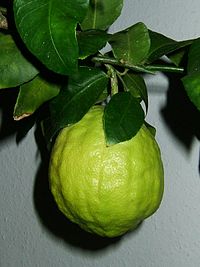This is an old revision of this page, as edited by Kazvorpal (talk | contribs) at 16:54, 20 June 2007. The present address (URL) is a permanent link to this revision, which may differ significantly from the current revision.
Revision as of 16:54, 20 June 2007 by Kazvorpal (talk | contribs)(diff) ← Previous revision | Latest revision (diff) | Newer revision → (diff)
| Citron | |
|---|---|

| |
| Scientific classification | |
| Kingdom: | Plantae |
| Division: | Magnoliophyta |
| Class: | Magnoliopsida |
| Order: | Sapindales |
| Family: | Rutaceae |
| Genus: | Citrus |
| Species: | C. medica |
| Binomial name | |
| Citrus medica L. | |
The citron (Citrus medica) is a species of citrus fruit. It is characterized by its thick rind and small sections. Generally, it is eaten preserved or in bakery goods, such as fruitcakes. (The candied peel rather than the fruit is often used in cooking.) In some culture, it is made into a fruity tea. The citron is mostly grown near the Mediterranean, parts of India, and in Central and South America. Pliny the Elder states that in his time, despite attempts to transport it into the Roman Empire in tightly-packed pots, the citron could only be grown in Media and Persia (HN xii.7), although there is evidence pointing to its cultivation in the Mediterranean during his lifetime. Zohary and Hopf believe this tree was first domesticated in India, and speculate that its wild forms, along with those of the mandarin and pomelo, were the original citrus species.
The citron goes by many names in different countries; one popular reference is cedrat, which is the French name for the fruit. Theophrastus referred to the citron as the Persian or Median Apple, and the fruit later came to be known as the Citrus Apple. Pliny calls the tree the Assyrian, or the Median, "apple" (the generic Greco-Roman name for globose fruits). Other citrus crops were not introduced to the Mediterranean basin until Islamic times.
In many languages other than English, a normal lemon is called a "citron" and a lime is called a "limon". Although the East Asian citrus fruit yuzu (also called yuja) is sometimes called a citron, it is actually a separate species, Citrus junos.
This plant should not be confused with the citron melon, or tsanna, a plant native to Africa, that is the ancestor of all watermelon.
Cultivation and uses
The citron fruit is slow-growing. The citron tree is typically grown from cuttings that are two to four years old; the tree begins to bear fruit when it is around three years old. The fruit is oblong in shape, and sometimes as much as six inches in length. Its skin is thick, somewhat hard, fragrant, and covered with protuberances; the pulp is white and subacid.
In Pliny's time the fruit was never eaten (it began to be used in cooking by the early 2nd century), but its intense perfume was used, penetrating clothes to repel noxious insects (compare Citronella).
In Hebrew, the citron is known as the etrog (Hebrew: אֶתְרֹג). It is one of the Four Species used during the holiday of Sukkot each fall. The role of the citron in that holiday was portrayed in the Israeli movie Ushpizin. Citrons that have been bred with lemon (in order to increase output per tree and make the tree less fragile) are not kosher for use as part of the Four Species.
In South Indian cuisine, especially tamil cuisine, citron is widely used in pickles and preserves. In Tamil, the unripe fruit is referred to as 'narthangai', which is usually salted and dried to make a preserve. The tender leaves of the plant are often used in conjunction with chili powder and other spices to make a powder, called 'narthellai podi', literally translating to 'powder of citron leaves'. Both narthangai and narthellai podi are usually consumed with thayir sadam.
In Korea, it is used to create a syrupy tea (called Yuja cha) where the slices of whole fruit are eaten with the sweet tea. The fruit is thinly sliced (peel, pith and pulp) and soaked or cooked in honey or sugar to create a chunky syrup. This syrupy candied fruit is mixed with hot water as a fragrant tea, where the fruit at the bottom of the cup is eaten as well. Often perserved in the syrup for the cold months, Yuja tea served as a source of fruit in winter.
See also
- Buddha's hand, a type of citron
Notes
- Daniel Zohary and Maria Hopf, Domestication of plants in the Old World, third edition (Oxford: University Press, 2000), p. 184.
- Zohary and Hopf, Domestication, p. 185